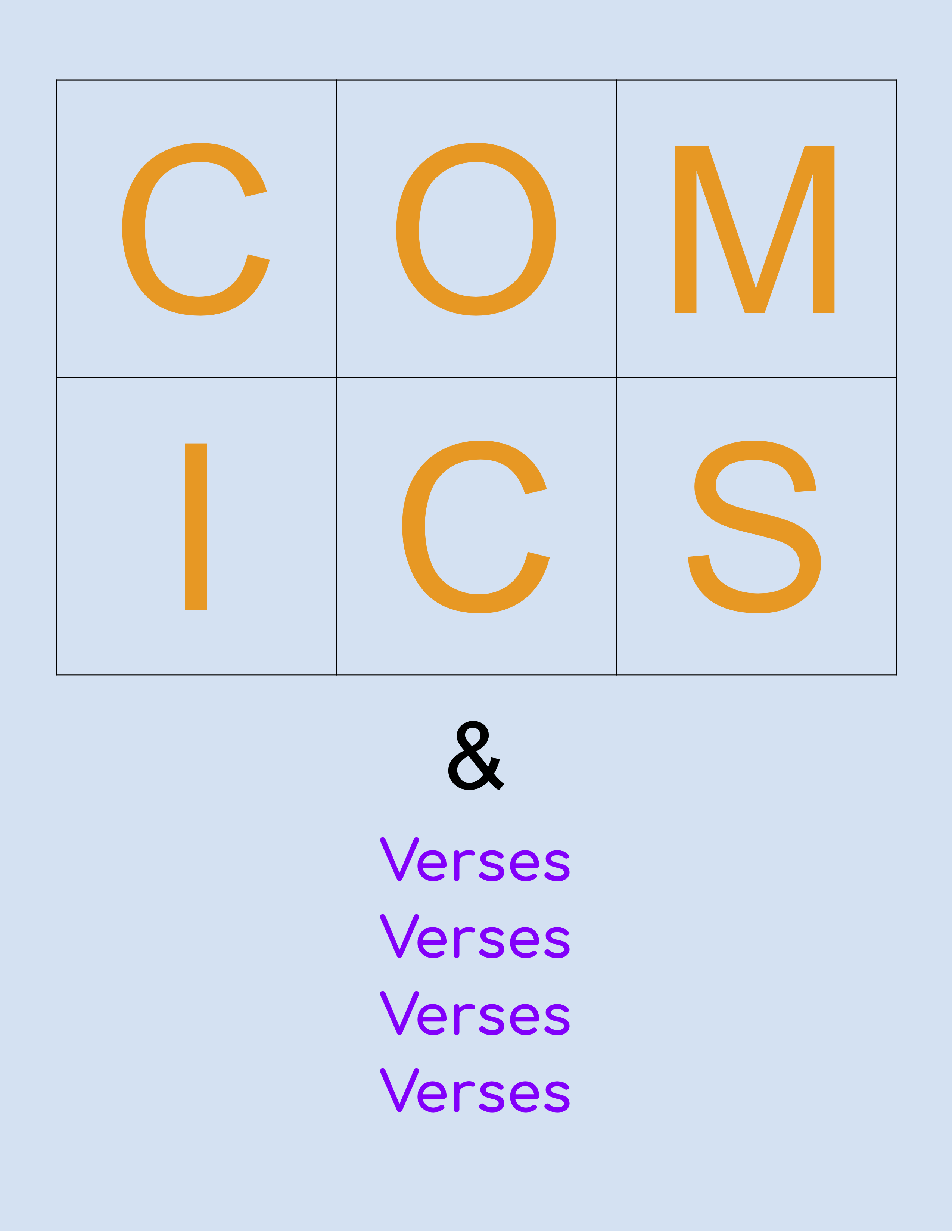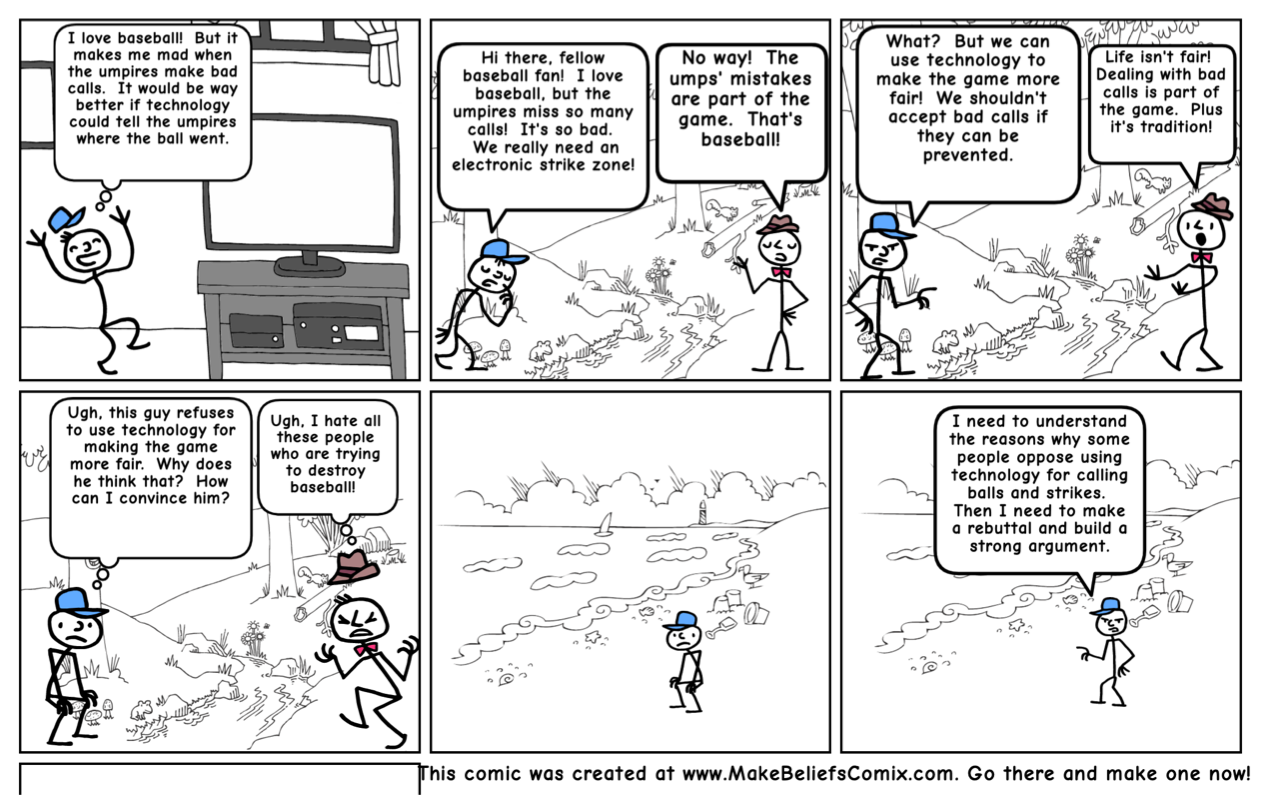| C | O | M |
|---|---|---|
| I | C | S |
&
Verses
Verses
Verses
Verses

COMICS & VERSES
is a two-part assignment intended to help students in social science and humanities courses (including Gen Ed courses) to develop effective and well-written opinion essays.
Jump to:
About The Assignment
The Assignment Prompt
About The Assignment
The point of the assignment is to make students navigate various kinds of constraints -- limitations of space, form, and functionality -- during the creative process, in order to push them to continually revise their work, do iterations, and ultimately express and present their arguments in a clear, concise, convincing manner.
OVERVIEW
In the first part of the assignment, the student uses an online tool to create a six-panel cartoon. The cartoon should present the issue/debate and the student’s position on it. The cartoon is essentially a model of an essay’s introductory paragraph.
Sample Cartoon:

In the second part of the assignment, the student writes a list of potential counterarguments (objections that a potential reader might bring up) and rebuttals (responses to those counterarguments), and then writes a poem based on these arguments. The poem will eventually become the body paragraphs of an essay.
Sample Poem:
You say baseball isn’t fair:
“Suck it up, respect the ump”
But the ump is not our God,
And I didn’t vote for Trump
You say framing is an art
That the robo-umps would kill
But deception isn’t right;
Framing’s cheating, not a skill
You say robo-umps won’t know
If the pitches look like strikes
But, objectively, the truth
Isn’t what the umpire likes.
Will the umpires lose their jobs?
Will the robots take their place?
No, the umps will still be there
To say, “Ball! Now take your base.”
“YAY, CONSTRAINTS!”
The cartoon’s main constraints are space and the functionality of the online cartoon tool.
In the cartoon there’s limited space for text within the thought and speech bubbles, especially since the characters and background images take up at least half of the available area within the frame. Moreover, the online tool is rather clunky, with limited options, templates, and functionality, so the interface itself is a constraint.
While doing the assignment myself as a test, I noticed that I revised the cartoon and rewrote its text more than ten times; this iteration helps to distill the thesis and refine the presentation of it.
The poem follows a strict set of rules of structure, rhyme, and meter.
The structure of the poem requires the student to come up with distinct counterarguments and rebuttals.
The formal constraints force revision and require the student to be clear yet succinct.
RATIONALE
Courses:
COMICS & VERSES is an activity that can be implemented in any course that requires the writing of opinion essays, including:
- social science courses
- humanities courses
- Gen Ed courses
- Expos courses
- Law courses
- Freshman Seminars
Research:
This assignment is rooted in two theoretical concepts, from two different sources:
Content:
- They Say, I Say: The Moves that Matter in Academic Writing (Graff & Birkenstein)
- “To give writing the most important thing of all -- namely, a point -- a writer needs to indicate clearly not only his or her own thesis, but also what larger conversation that thesis is responding to.” (18)
- “What would a naysayer say about my argument? What is my evidence?” (XV)
Process:
- Creative Confidence, Chapter 4
- Making “hundreds of small iterations” to make something work and to improve it (113)
- “Rapid and continuous improvements” (122)
- “Use constraint to fuel creative action. . . . Constraints can spur creativity and incite action, as long as you have the confidence to embrace them. . . . Use constraints as a source of creative license, as permission to think differently.” (126-128)
- (constraints of time, form, space, interface, technology, etc.)
Me:
In creating this activity, I’ve been compelled to think about various types of constraints and their relation to learning.
How does the friction caused by limitations of space, format, form, and functionality push people to reformulate, revise, refine, and improve the presentation of their ideas, and perhaps even the ideas themselves?
To explore this, I completed the entire activity as though I were the student. I learned to use the MakeBeliefsComix online tool, and I learned to write a specific type of poetry.
Most importantly, in discussing my activity with the Learning Lab staff and fellows, I had a chance to think through the concept of valuable friction -- in other words, ways in which constraints can have a fruitful consequence in thinking, writing, and learning.
What have I done?
- I have written the activity prompt, which can be adapted by instructors for their courses.
- I have completed the activity myself, so that the students will have samples for reference.
What have I learned?
- My colleagues at the LL -- including the directors, the staff, and my fellow fellows -- have pushed me to do iterations of the assignment prompt, so as to distill its useful elements, make sure that it’s effective, and justify and explain that effectiveness in the prompt itself as well as in my testing instructions for LLUFs. The weekly LLGF seminar has given me ideas and specific texts to use as a theoretical underpinning of my assignment. My meetings with Lauren and her comments have been particularly helpful in making my project’s aims more transparent and more promising.
The Assignment Prompt
COMICS AND VERSES: Developing an Essay through Playful Friction
OVERVIEW
In this activity, you will create your own cartoon and compose a poem! The objective is to think creatively within constraints of functionality, space, and form. This process will help you to brainstorm, play with ideas, and plan out a thoughtful, tight, well-balanced essay.
PART 1
In the first part of this activity, you’ll think of a topic for an opinion essay, taking a side on a contentious issue, and you’ll create a 6-panel cartoon that presents the issue to be debated and your opinion/stance on it. Think of the cartoon as a model of an essay’s introductory paragraph. You’ll make the cartoon using a web-based tool. The main constraints of the cartoon are space and the functionality of the online cartoon tool. In the cartoon there’s limited space for text within the thought and speech bubbles (especially since the characters and background images take up at least half of the available area within the frame), so you may need to do multiple revisions and iterations of the cartoon’s text and layout. Moreover, the online tool is rather clunky and full of friction, with limited options, templates, and functionality, so the interface itself is a constraint. Embrace these constraints, as they will compel you to identify what’s most important and to distill and refine your arguments and your presentation of them.
Follow these steps for the cartoon portion of the assignment:
- Think of a topic for an opinion essay, taking a side on a contentious issue.
- Look at the sample cartoon at the end of this document.
- Complete this intro tutorial that teaches you to use the cartoon-making tool.
- Focus on the “Character,” “Balloons,” and “Background” functions.
- Go here to create your own cartoon.
- Save the completed cartoon to your computer.
PART 2
In the second part of this activity, you’ll write a 16-line rhyming poem in four stanzas, with each stanza corresponding to a counterargument and your rebuttal. Think of the poem as corresponding to the body paragraphs of an opinion essay.
Before you start writing the poem itself, you’ll make a list of four potential counterarguments, including your rebuttals to each of those.
The poem follows a strict meter and rhyme pattern. This formal constraint will require you to limit the number of words and to revise your poem through multiple iterations. Again, embrace this part of the creative process: overcoming these elements of friction will push you to diligently refine and playfully express your arguments.
Follow these steps for the poem portion of the assignment:
- Look at the sample list of arguments and rebuttals at the end of this document.
- Make a list of four arguments opposing your position, and rebuttals of those arguments
- Look at the sample poem at the end of this document. Notice the following formal elements:
- Each 4-line stanza consists of a counterargument and a rebuttal (2 lines each)
- Each line has 7 syllables, with the following rhythm: ta-ta-TUM-ta-ta-ta-TUM
- Within each stanza, the second line rhymes with the fourth line (to look up words that rhyme, you can use www.rhymezone.com)
- Write a 16-line poem in 4 stanzas, adhering to the three rules of form listed above.
Feel free to be a bit silly and to say things in your cartoon and poem that you wouldn’t write in an essay. Think of the cartoon and poem as fun things that you’ll share with your classmates as a precursor to writing. You won’t be graded on these!
Sample Cartoon, List, and Poem
Sample Cartoon:

Sample of opposing arguments and rebuttals:
A: Life isn’t fair. People need to learn to deal with it and accept that, and respect authority;
R: People should be encouraged to challenge authority and seek truth using empirical evidence
A: “Framing” (which means moving the glove into the zone after catching the ball) is a key skill in baseball, and it would become obsolete if the electronic strike zone were implemented;
R: Framing is deception of the umpire; it has no legitimate place in the game; players should focus on other skills that are part of competing against the other team, not the umpire
A: Some pitches that are technically strikes don’t look like strikes and should be called balls;
R: A strike is a strike. It’s objective, not subjective. It doesn’t matter what a pitch looks like.
A: Umpiring is a craft; umps will lose their jobs;
R: Umps will still be needed, to announce the calls, and for calling subjective things such as interference, swings, etc.
Sample Poem:
You say baseball isn’t fair:
“Suck it up, respect the ump”
But the ump is not our God,
And I didn’t vote for Trump
You say framing is an art
That the robo-umps would kill
But deception isn’t right;
Framing’s cheating, not a skill
You say robo-umps won’t know
If the pitches look like strikes
But, objectively, the truth
Isn’t what the umpire likes.
Will the umpires lose their jobs?
Will the robots take their place?
No, the umps will still be there
To say, “Ball! Now take your base.”